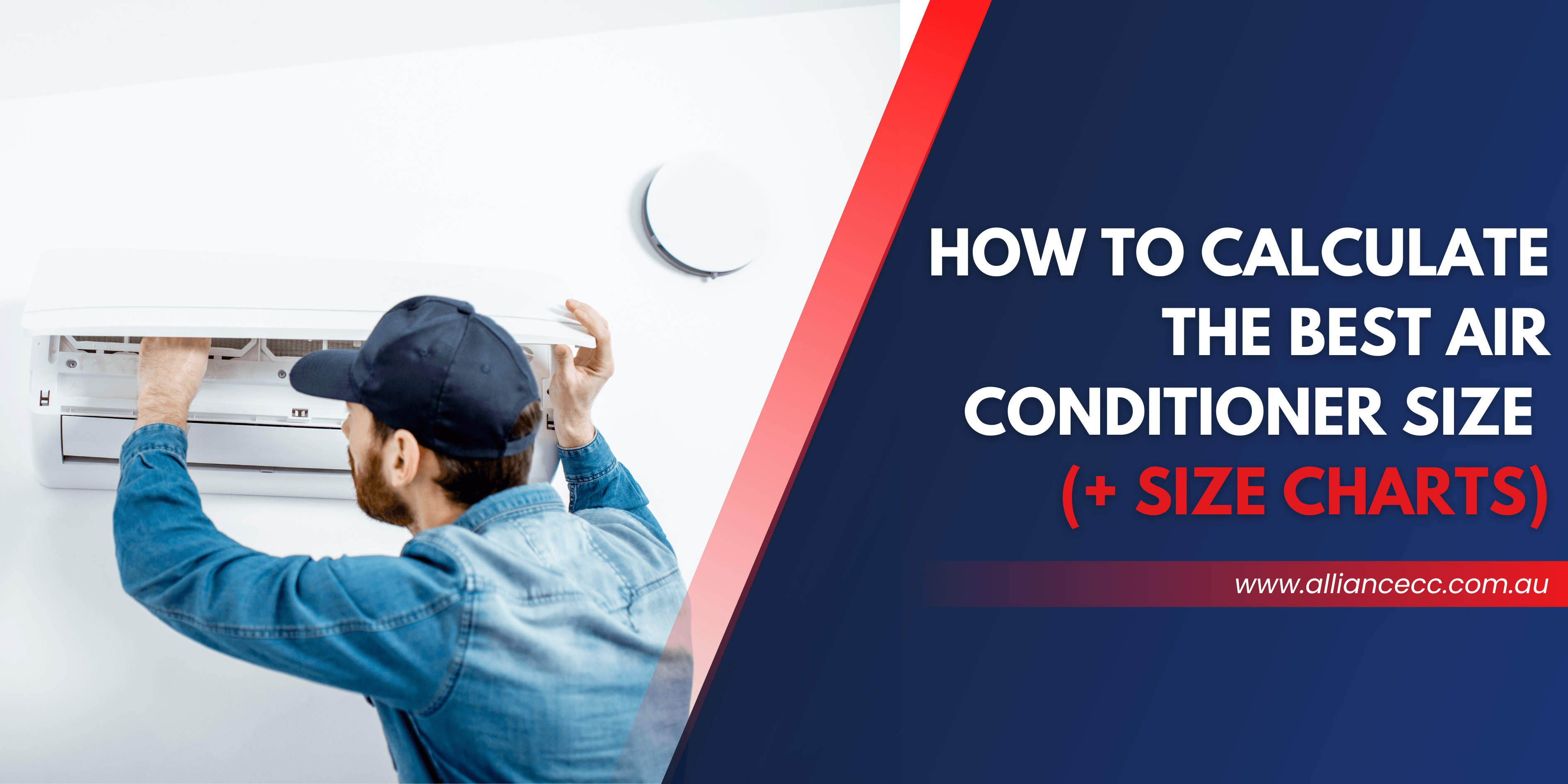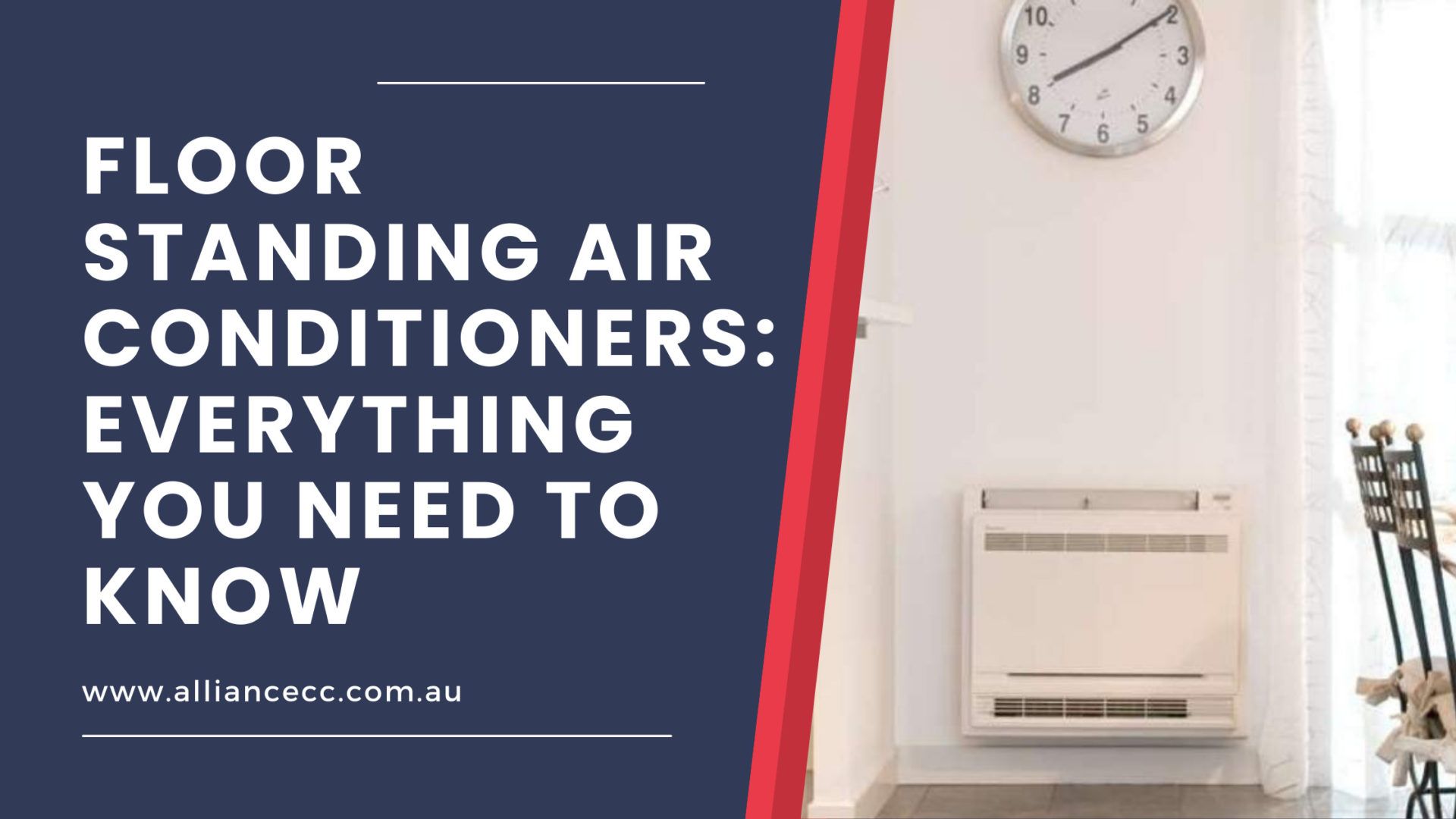

People tend to assume that having a high–capacity air conditioner is better – this is not always true, and you may end up with hefty electricity bills.
To calculate the size of the air conditioner you need, you can manually calculate the area and cooling load of your home or room, use an online cooling load calculator, or speak to an industry professional. If your air conditioner is missized, it will run too much, doing more wear to the unit and adding to your bills.
As you can see, having an air conditioner of the correct capacity for your home is important for new air conditioning installation. In this article, you’ll learn how to calculate the right air conditioner size for your property.
Read on to find out more!

Air Conditioning Sizes Calculator
m
m
Results
Average Height Ceiling, Pitched Roof
Kw
Flat Tin Roof, Little To No Insulation
Kw
How Is AC Size Measured?
Air conditioner size is measured in ‘kW, or Kilowatts – the base unit of energy used to measure most appliances’ electricity usage. A Kilowatt is equal to 1,000 watts. The higher these numbers are, the higher the energy consumption. Higher energy consumption also means a higher cooling capacity.
The Kilowatt measurement included in an air conditioning unit’s specifications (or sometimes the name) is directly proportional to its cooling capacity. This allows the manufacturers, salespersons, and consumers to use this as a benchmark to determine if the AC unit can effectively and efficiently cool an interior based on its kW rating.
In this regard, it is essential to remember that it isn’t always wise to go for the most expensive, powerful air conditioner you can buy. Instead, you should try to calculate how much cooling capacity is needed by the room where the AC unit will be installed. You want to avoid buying an air conditioner that is too weak or too strong for the intended room.
What to Consider When Sizing Your Air Conditioner
Planning to install a new air conditioner or replace your air conditioning system? Here’s what to consider when calculating the right AC size:
Room Sizes
A single air conditioner won’t be enough to cool your home, though this will depend on the size of your home. Even if you install an air conditioner in every room, you’ll need to be mindful of the rooms’ sizes.
Before shopping for a new air conditioner, measure your rooms’ height, length, and width and give this data to your air con installer. You can also use an air conditioning size chart or calculator to estimate. However, with so many factors influencing the right air conditioner size, consulting a professional is the most reliable method.
Home Insulation
How well-insulated your rooms are will play a significant role in determining the size of your air conditioner. For instance, when a home is well insulated, it traps hot and cold air better, requiring only a low-capacity air conditioner to regulate temperatures.
Location of the Room
If the room you’re going to install the air conditioner in faces north or west, chances are it can get sweltering during the summer. For rooms like this, you may need to install a high-capacity conditioner to keep the room cool.
Placement of Air Conditioner
The placement of the air conditioner in any given room affects how much cooling capacity you need. This is also affected by what kind of air conditioner you are planning to install. However, the general idea is that you want the air conditioners placed in a relatively ‘central’ location to ensure a balanced airflow.
For bedrooms, the best position is where the air will not directly flow over the bed, as this is widely considered uncomfortable and may sometimes even cause dry eyes and a sore throat, among others. It’s best to place it on a wall above the bed’s headboard and to one side if it’s a split type. For window types, placing it a little higher than the bed would ensure that air does not directly blow into the person sleeping. Note that cold air ‘sinks’ while hot air rises, so make sure that air conditioners are not installed too low in a room.
If you cannot place your air conditioner in the aforementioned ideal spots, then sizing your AC a little higher or lower may be necessary. For instance, if you are forced to place a split AC unit too far from the bed in a bedroom, you may have to get a slightly larger AC unit to compensate.
Window Glazing
A window’s glazing plays a significant part in how cool or hot a room is, even with an air conditioner turned on. As much as 87% of a room’s heat may be gained through windows alone. Improving the window’s thermal performance will help keep the room cooler.
Glazing is only done to the glass part of your windows but may also be done on skylights if necessary. Although in some cases, the term also refers to the frame and furnishings of a window/glass pane. Consider glazing your windows if your air conditioner is working too hard to achieve the desired temperature. However, remember that too much unnecessary glazing may lead to unintentional heat gain during summer and heat loss and condensation during winter.
If you have windows with poor thermal performance, size your AC unit up by a couple of kilowatts. On the other hand, if your windows are “over-glazed,” you might want to size your air conditioner a little lower.
Type of Air Conditioner
Not all air conditioners are the same. Different types of air conditioners have different ways of circulating the air inside a room, so sizing the AC unit higher or lower than deemed appropriate for a room may be necessary.
For instance, ducted AC units generally provide very balanced airflow throughout different rooms, so an appropriately sized AC unit based on the room dimensions will suffice. However, their placement inside a room will greatly affect the cooling performance of window and split-type air conditioners since they only blow air in a specific direction. Despite this, you will rarely have to size your AC unit down.
Climate
Arguably one of the most crucial factors to consider when sizing an AC unit. Due to Australia’s geography and location on the planet, the climates across different states and territories vary greatly. They will require an adjustment of your air conditioner’s cooling capacity.
But as a rule of thumb, if you reside in an area where temperatures exceed 35 degrees Celsius, you will have to size your AC unit by a couple of kilowatts more. This is because hotter environments decrease an AC unit’s efficiency, resulting in less cooling capacity.
Running Costs
As previously stated, an air conditioner with more cooling capacity will consume more energy whenever it is operational. This matters for individuals or households with energy constraints. As such, households that cannot or prefer not to consume too much energy may choose a smaller air conditioning unit. However, if the AC unit has to work too hard to cool the room, this can sabotage the goal of reducing your air conditioning bills.
How Do You Calculate the Size of the Air Conditioner You Need?
Calculating the size of the air conditioner you need ensures the right sized model is installed in your home. Below are the three easiest ways to calculate the size of the air conditioner you need.
Manually Calculating the Area of Your Room
There is a formula used to get a relatively good estimate of how much cooling capacity your room would require:
- The first step is to measure the length and width of the room and multiply them. If you’re planning to cool multiple rooms with a single AC unit, repeat this step for every room, then add the area of each room for the total. The figure will have to be in square metres.
- Next, multiply the living area you have just calculated by a specific number depending on the room’s/ interior’s ceiling height. For ceilings that are 2.4 metres high, multiply by 150 (watts). For those 2.7 metres high, multiply by 160 (watts). Lastly, for those that are 3 metres high, multiply by 175 (watts).
- The resulting number represents the general estimate of wattage required to cool the room/s properly. You may convert this into kilowatts by dividing the wattage by 1,000.
Here is a sample calculation for a house with a living area of 100 square metres and a height of 2.4 metres:
100 square metres x 150 watts = 15,000 watts
15,000 watts ÷ 1,000 = 15 kilowatts.
Using an Air Conditioner Size Calculator
A simpler way of identifying the AC unit with a suitable cooling capacity for your room is by using an air conditioner size calculator. These calculators take several factors into account and calculate them based on the numbers you input. However, similar to manual calculation, these calculators are only meant to act as a general guide/ estimate. They should not serve as the sole determiner.
For an independent estimate, try the FairAir Cooling Load Calculator which considers your location, room area, building materials, and insulation.
Working With an Air Conditioning Specialist
The best and most reliable way to determine the cooling capacity requirements of your room/s or house is by consulting and working with an air conditioning specialist. These professionals have often been in the HVAC industry for years.
They have gained a lot of experience and knowledge throughout the years. Working with an air conditioning specialist lessens the possibility of error with manual calculations/estimations and ensures the AC unit size recommended for your needs is accurate.
Air Conditioner Room Size Chart
An estimate of the air conditioner size for rooms can be found in the table below:
| Room Area | Type of AC Capacity | Approx AC Capacity | Most Common AC Size | Type of Room | Type of Air Conditioning |
| 10m2 – 20m2 | Small Capacity | 2 to 2.8kW | 2.5kW | Small bedroom
Study or office Enclosed kitchen |
Portable Window AC Split System |
| 20m2 to 30m2 | Small or Medium Capacity | 2.5kW to 5kW | 3.5kW | Small living area
Ensuite bedroom High ceilings |
Window AC Split System |
| 30m2 to 45m2 | Medium Capacity | 5 to 6 kW | 5.6KW | Split System | |
| 45m2 to 60m2 | Medium or High Capacity | 6kW to 8kW | 7kW | Master suite
Medium living area Large kitchen |
Split System |
| Over 60m2 | High Capacity | 8kW to 9KW | 8.5kW | Open plan homes
Large living areas Shop |
Split System Ducted AC |
Note that one of the most significant factors will be your location. For instance, a 30m2 room in Darwin may need a 2.6kw capacity air conditioner, compared to 2.2kW in Sydney and just 1.1kW in Tasmania.
That’s why it’s important to consult an air conditioning installation professional for a heat load calculation. Size charts can give you a starting point, but only a specialised air con installation service can ensure all the variables are considered.
Why Does the Size of My Air Conditioner Matter?
An air conditioner that is too small will not be able to cool the room or reach the desired temperature quickly. On the other hand, an AC unit that is too large in terms of cooling capacity will reach the right air conditioning temperature quickly, and consume too much electricity, harming its efficiency.
Having an air conditioner is one thing; having an appropriately sized one is another. Using an AC unit which is too small or too large for the room it is installed in is highly discouraged since it will not operate optimally.
What Happens if My Air Conditioner Is Too Small?
When you install an air conditioner that has a lower capacity than what’s required for your home, it’ll work non-stop trying to keep your home cool, but it won’t be strong enough, leaving your home warm and your electricity bills high.
What Happens if My Air Conditioner Is Too Big?
If an air conditioner is too powerful, it’ll cool down the room too quickly, and cause it to turn off and on frequently; this cycle is inefficient and could lead to breakdowns. People tend to assume that having a high–capacity air conditioner is better, but you’ll actually end up with hefty electricity bills.
Keep Your Home Cool and Electricity Bills Low
A right-sized air conditioner used at the ideal temperature setting can work efficiently for a long time without needing maintenance, saving you money.
At Alliance Climate Control, we provide air conditioning maintenance to keep your air conditioning in great shape so that you can stay cool for the summer.
Call us on 02 8061 5023 and speak to our air conditioning specialists today.
Related Questions
Is It Better to Oversize or Undersize Air Conditioners?
Although you should try and accurately size your air conditioner, it’s better to oversize your air conditioner than undersize it. While an undersized AC unit will struggle to room a room properly and in a timely manner, an oversized AC unit won’t. It will use excess power, but it will cool a room regardless.
Are All Air Conditioners the Same Size?
No, air conditioners come in varying cooling capacity sizes, affecting their physical size. Air conditioning units intended to cool larger rooms (regardless of the type of air conditioner) will usually be larger. As such, it is also important to consider the room’s physical space when purchasing an air conditioner.
What Size Room Will a 1.5 kW Air Conditioner Cool?
A 1.5-kilowatt air conditioner is rated to cool a 10 square metre room with relative ease. This isn’t taking into account the local weather, the type of air conditioner or the insulation of the room, all of which can affect the unit’s efficiency.
What Size Room Does a 2.5 kW Air Conditioner Cool?
A 2.5-kilowatt air conditioner will be able to cool effectively 15 square metre room on average. However, things such as what type of air conditioner you have, where it’s installed and your local climate will affect how efficiently the unit runs.
What Size Room Will a 3.5 kW Air Conditioner Cool?
A 3.5-kilowatt air conditioner will be able to sufficiently cool a 25 square metre room on average. However, this does not consider multiple other factors, such as climate, type of air conditioner, and placement, among others.
Related Articles








